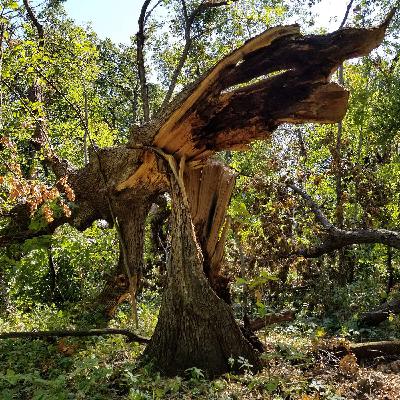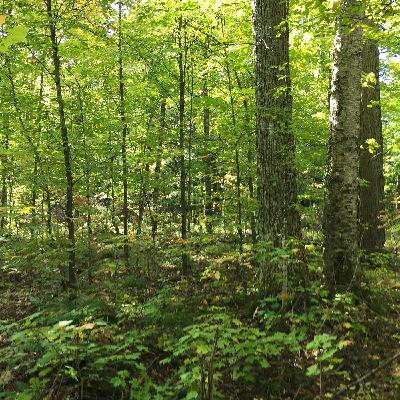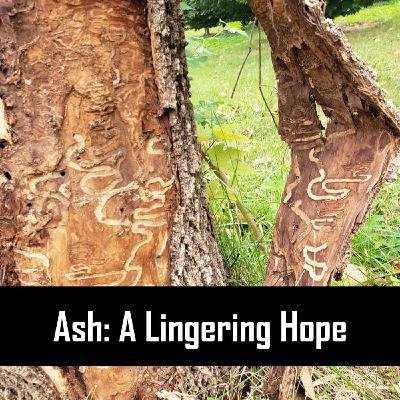Discover SilviCast
SilviCast

SilviCast
Author: Wisconsin Forestry Center and Wisconsin Department of Natural Resources
Subscribed: 80Played: 1,417Subscribe
Share
© 2025 SilviCast
Description
SilviCast is a podcast devoted to silviculture: the science, practice, and art of forestry. We explore current topics in forest management, highlight innovative practices, and interview practitioners and researchers aiming to solve challenges facing today’s managers. The show is tailored for foresters and other land managers, whether it’s listening at the office or in the truck on the way to the field. SilviCast is hosted by Wisconsin Department of Natural Resources silviculturists Greg Edge and Brad Hutnik and produced by the University of Wisconsin-Stevens Point’s Wisconsin Forestry Center.
60 Episodes
Reverse
The legacy of the “cutover” has left much of the Lake States—and many other regions—with a dominance of even-aged forest stands. Today, both landowners and foresters increasingly consider converting these stands to uneven-aged management to achieve a range of ecological, economic, and aesthetic goals. However, the outcomes of these efforts—even after multiple stand entries—have sometimes fallen short of expectations. Significant silvicultural challenges remain in determining the most effectiv...
Restoring and reforesting floodplain forests is no small feat—these ecosystems are as fascinating as they are complex. While they face many of the same disturbances as upland forests, bottomland ecosystems are uniquely shaped by water. Adding to this challenge of hydrology are the profound impacts of levies, agriculture, dams, and other disturbances. In this episode of SilviCast, we dive deep into the world of bottomland forest restoration with insights from national experts at the 2025 North...
Sometimes, a simple “silvicultural tweak” can make a big difference in achieving diverse forest management goals. The real challenge lies in knowing when—and how—to make those adjustments. To help with that, several states have created Forestry for the Birds guidebooks, offering practical strategies to enhance forest habitat for birds. In this episode of SilviCast, we’re joined by Christian Nelson, Lake States Coordinator for the Forest Stewards Guild, to discuss the newly released Forestry f...
Eastern black walnut holds an almost legendary reputation as one of the most valuable timber species in central and eastern North America. A single, high-quality tree can fetch thousands of dollars—sometimes even influencing the outcome of an entire timber sale. With that level of interest, you’d think we’ve uncovered everything there is to know about this remarkable species. And while researchers and foresters have developed extensive knowledge around its silviculture and genetics, there’s s...
Foresters are pretty good at stand-level silviculture. But what if we want to make changes to forest vegetation at a much larger scale? Silviculture at scale to impact landscape-level change is much trickier, whether that’s aiming for a target age-class distribution or meeting the broad habitat needs of birds. Where do we even begin? In walks the concept of Dynamic Forest Restoration Blocks, or the strategy of breaking up the landscape into manageable and biologically meaningful units w...
Garlic mustard blooms, panic ensues! Many foresters in the eastern hardwood forests of North America can appreciate this sentiment as they see yet another invasive plant, garlic mustard, colonize their woodlands and forests. Maybe they just make note of it on the inventory or maybe they prescribe an aggressive treatment plan of pulling and herbicides. But maybe there is a different approach… time. Join us on this episode of SilviCast as we talk with Dr. Bernd Blossey, Professor at Cornell Uni...
Buckthorn has been the bane of many foresters and forest landowners throughout eastern North America. This long-lived, woody plant is capable of forming dense thickets, degrading native understory plant communities and impeding tree regeneration. While herbicide control measures can be effective, managers have struggled for long-term control of this prolific plant. Join for this episode of SilviCast as we explore ways to disrupt the buckthorn cycle with Dr. Mike Schuster, Researcher at the Mi...
It’s hard to turn around these days without seeing or reading something about UAVs or Unmanned Aerial Vehicles. Drones are becoming an increasingly important tool in many fields, including within the practice of silviculture. On this episode of SilviCast we explore the soaring use of drones for site preparation and release treatments. Join us for a conversation with Rick Hill, Regional Silviculturist and Reforestation Specialist with Michigan DNR and Kyle Schempp, Project Manager and Drone Pi...
Foresters are increasingly aware of the importance of prescribed fire as a silvicultural tool in the maintenance and management of fire-adapted forest ecosystems. At the same time concerns remain over the impact of those fires on the timber resource. Join us for a conversation with Mike Saunders, Professor of Silviculture in the Department of Forestry and Natural Resources at Purdue University, as we explore the effects of prescribed fire on tree wounding and timber quality in the oak-h...
German foresters sometimes named silvicultural systems after the region where the treatment was developed and practiced. So it is with the Acadian femelschlag, a locally developed gap-based system designed to restore species diversity and structure to the mixedwood Acadian forests of Maine and eastern Canada. Join us on this episode of SilviCast as we talk with Robert Seymour, Curtis Hutchins Professor Emeritus of Silviculture at the University of Maine, about what he has learned from over fo...
Foresters need to make decisions every day, and sometimes difficult decisions as we attempt to understand and address the diverse needs of the land, the landowner, and others. Similar to marking a tree, these decisions often require us to walk all the way around to see an issue from all sides. Join us on this season 5 finale of SilviCast as we talk with Marianne Patinelli-Dubay, Environmental Philosophy Program Coordinator at the State University of New York, College of Environmental Science ...
We’ve all seen it in the field… Aldo Leopold alluded to it… parts of a forest ecosystem are missing or changed. Now the forest doesn’t respond the same to silvicultural treatments that worked in the past. The forest is less predictable. In other words, the forest has lost memory, specifically ecological memory. Join us on this episode of SilviCast as we explore the concept of ecological memory with Chris Webster, professor of quantitative ecology at Michigan Technological University. Learn ho...
The paint gun is a basic tool of the forestry trade. But what happens when we’re two forties into the woods and our paint gun goes down? This can put a major clog in our day. Maybe the problem with our paint gun is us? Join us on this episode of SilviCast as we talk with three experts in the field about Trecoder, Panama, and Nel-Spot paint guns. Ethan Tapper with Bear Island Forestry, John Freeman with Panama Forestry Equipment, and Ryan Holm with Nelson Paint give us tips to keep our paint g...
Most of us enjoying a little on-the-job foraging… some blackberries here, some morels there. But how often do we think about intentionally managing non-timber forest products? Forest farming is an agroforestry practice than involves the intentional stewardship of edible, medicinal, and decorative crops beneath a forest canopy. Join us as we discuss the integration of forest farming and silviculture with Eric Burkhart, Teaching Professor in the Department of Ecosystem Science and Managem...
If you are a forest practitioner in the eastern forests of North America (and maybe elsewhere) at one time or another you have likely been frustrated by white-tailed deer. Browse impacts on forest vegetation are significant and long-lasting, but those impacts are not the same everywhere making deer browse a challenging issue to both understand and address. Join us on this episode of SilviCast as we seek to better understand how deer impact our forests and what clues the latest science holds f...
It’s an all too familiar scenario to foresters…a new pest is introduced into another part of the range and slowly works its way to a forest near you. So it goes with the hemlock woolly adelgid (HWA) that was introduced into eastern North America over 70 years ago. HWA has not yet arrived in Wisconsin, but can we learn from the research and field experience of our colleagues in the east? Are there silvicultural approaches that can be used to make hemlock trees and stands more resilient, ...
If foresters have a super-power, it might just be the power of observation. They notice change in the forest and correlate facts that would otherwise be isolated and missed. As a result, foresters have the unique ability to adapt and find management solutions in a changing environment. In this episode of SilviCast we will explore an example in Iowa of changing environmental conditions and the cumulative effects on white oak (Quercus alba), and one forester’s quest to find answers. Join our co...
It pays to be observant! Ogijewski, a forest scientist working in Russia in the early 1900s observed that oaks sometimes regenerated in small clusters where wild boars disturb the forest floor. From this simple observation he developed a reforestation method called cluster planting, the planting trees or seeds in tightly-spaced, small functional groups. The method caught on in Europe and is now practiced as a way to decrease planting costs and restore stand diversity. In this episode of...
It’s not worth saying anything unless it’s worth taking a long time to say, to paraphrase Treebeard in The Lord of the Rings. And sometimes you need to play the long game if you’re a research forester too. Long-term silvicultural studies are surprisingly rare, but extremely valuable. That is why a recent paper on six decades of selection cutting results got our attention. The Cutting Methods Study is a long-term investigation of cutting systems in second-growth northern hardwood stands on the...
Sometimes foresters in eastern North America may feel as if they are in a Lemony Snicket novel, with chestnut blight, spongy moth, Dutch elm disease, and emerald ash borer creating a continuing series of unfortunate events. Emerald ash borer or EAB is one of the most recent invasive pests with the potential to eliminate an entire tree species. And foresters have many questions on how to manage EAB impacted stands and what they can do to help maintain ash trees as a component of our fore...
























